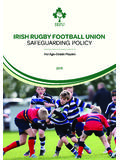Transcription of Engineering Controls/Ventilation Control of chemical and ...
1 RUBRIC DEFINITIONS Examination questions are categorized in the following rubrics (subject areas): Air Sampling and Instrumentation Selection, use and limitations of field air sampling instruments, full shift and grab samples, including direct reading instruments. Also included are the set up, calibration and use (including quality assurance practices) of air sampling apparatus and direct reading instruments, sampling strategy considerations and calculations related to sampling and calibration. Measurement of exposures to noise, ionizing radiation, nonionizing radiation, and thermal stressors are included in the rubrics dealing with those specific subject areas.
2 Analytical Chemistry Laboratory analytical procedures for work place environmental samples and related calculations. Included are gas chromatography, infrared, visible and ultraviolet spectrophotometry, high performance liquid chromatography, mass spectroscopy, atomic absorption spectrophotometry, wet chemical methods, and microscopy and laboratory quality assurance and chain of custody. Basic Science General scientific concepts, chemistry, biochemistry, biology, anatomy and physiology, general physics and mathematics. Properties of flammable, combustible and reactive materials (compatibility) are included as are calculations such as those relative to gas laws, airborne concentrations, and unit of measure conversions and conditions of non standard pressure.
3 Biohazards Principles of sanitation, personal hygiene, the recognition, evaluation and Control of biological agents or materials having the capacity to produce deleterious effects upon other biological organisms, particularly humans (virus, bacteria, fungi, molds, allergens, toxins, recombinant products, bloodborne pathogens, etc.) and infectious diseases that appear in workplaces including industry, agriculture, homes, offices and health care facilities. Biostatistics & Epidemiology Principles of epidemiology, techniques used to study the distribution of occupationally induced diseases and physiological conditions in workplaces and factors that influence their frequency.
4 It includes concepts of prospective and retrospective studies, morbidity and mortality and animal experimental studies, data and distribution of data as well as basic biostatistics and statistical and non statistical interpretation of data in the evaluation of hazards. Community Exposure Air pollution, air cleaning technology, ambient air quality considerations, emission source sampling, atmospheric dispersion of pollutants, ambient air monitoring, health and environmental effects of air pollutants and related calculations. Also included are other IH related environmental subjects such as emergency planning and response, water pollution, hazardous waste, and environmentalfate and transport.
5 Engineering Controls/Ventilation Control of chemical and physical exposures through Engineering measures such as local exhaust ventilation , dilution ventilation , isolation, containment and process change. Also included are mechanics of airflow, ventilation measurements, design principles and related calculations as well as in plant recirculation air cleaning technology. Engineering Control of ionizing and nonionizing radiation, thermal stressors, and noise and vibration sources including principles of isolation, enclosure, absorption and damping are included in the rubrics dealing with those specific subject areas. Ergonomics Application of principles from anthropometry, human factors Engineering , biomechanics, work physiology, human anatomy, occupational medicine and facilities Engineering to the design and organization of the workplace for the purpose of preventing injuries and illnesses.
6 Health Risk Analysis and Hazard Communication Understanding of principles and requirements for the interpretation and use of guidelines for the assessment of health hazards, including American Conference of Governmental Industrial Hygienists (ACGIH) Threshold Limit Values (TLVs), Biological Exposure Indices (BEIs) and industrial ventilation guidelines, American National Standards Institute (ANSI) standards, American Society for Heating, Refrigeration, and Air Conditioning Engineers (ASHRAE) guidelines, American Society for Testing and Materials (ASTM) standards, and National Institute for Occupational Safety and Health (NIOSH) Criteria Documents and recommendations.
7 Understanding of the risk reduction process including the hierarchy of controls, Control banding and hazard communication and training of employees are included. Communication of recommendations by appropriate techniques to implement Control actions is also included. IH Program Management Acquisition, allocation and Control of resources to accomplish industrial hygiene anticipation, recognition, evaluation and Control objectives in an effective and timely manner. Included are such topics as auditing, investigation methods, data management and integration, establishment of policy, planning, delegation of authority, accountability, risk communication, organizational structure, decision making and the ABIH Code of Ethics.
8 Noise Health effects resulting from exposure to noise and vibration. Computations related to combining noise sources and octave band measurements are included as are audiometric testing programs. Includes exposure measurement, evaluation, and Control . Non Engineering Controls Personal protective equipment, including the principles governing selection, use and limitations of respirators and protective clothing. Included are respirator fit testing, breathing air specifications, glove permeability, eye protection and the use of administrative Physical characteristics and health and biological effects associated with alpha, beta, gamma, neutron and x radiation, including source characteristics.
9 Includes exposure measurement, evaluation, and Control . Radiation/Nonionizing Physical characteristics and health effects associated with electromagnetic fields, static electric and magnetic fields, lasers, radio frequency, microwaves, ultraviolet, visible, infrared radiation and illumination. Includes exposure measurement, evaluation, and Control . Thermal Stressors Adverse health effects associated with heat and cold, symptoms of temperature related health effects, exposure Control techniques, and first aid/medical response. Toxicology Health effects resulting from exposure to chemical substances including single agents and mixtures, and natural and synthetic agents.
10 Included are symptomatology, pharmacokinetics, mode of action, additive, synergistic and antagonistic effects, routes of entry, absorption, metabolism, excretion, target organs, toxicity testing protocols and aerosol deposition and clearance in the respiratory tract. Also included are carcinogenic, mutagenic, teratogenic and reproductive hazards. Work Environments and Industrial Processes Included are the hazards associated with specific industrial or manufacturing processes. Topics include, but are not limited to confined space entry, spray painting, welding, abrasive blasting, vapor degreasing, foundry operations, and hazardous waste site remediations, as well as general indoor environmental issues.






